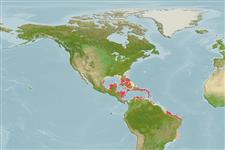Common names from other countries
Environment: milieu / climate zone / depth range / distribution range
Ekologi
laut berasosiasi dengan karang; kisaran kedalaman 2 - 24 m (Ref. 9710). Tropical; 36°N - 25°S, 99°W - 32°W
Western Atlantic: North Carolina, USA and Bermuda to Brazil.
Size / Weight / umur
Maturity: Lm ? range ? - ? cm
Max length : 18.0 cm TL jantan/; (Ref. 7251)
Duri punggung (Keseluruhan (total)) : 9; duri punggung lunak (Keseluruhan (total)) : 11; Duri dubur: 3; Sirip dubur lunak: 11. Wide black stripe through eye to base of tail, bordered above by prominent gold line. Large black spot on mid-side. Large black spot on mid-side above origin of anal fin (Ref. 26938). Three transverse red bands on top of head; large adult males become primarily rose and green, lose the dark lateral stripe, gain a prominent black spot on mid-side, and have a larger black spot in the spinous portion of the dorsal fin (Ref. 13442).
Abundant on reef tops and in shallow rocky areas. Found to depths of at least 25 m (Ref. 26938). Also found in Sargassum beds (Ref. 9626). Solitary and wary and can be difficult to approach (Ref. 26938). The tricolored pattern of the initial phase is similar to that of the juveniles of the yellowmouth grouper, Mycteroperca interstitialis, an aggressive mimic (Ref. 43465). A protogynous hermaphrodite (Ref. 55367). Generally of no interest to fisheries because of its small average size (Ref. 5217).
Life cycle and mating behavior
Maturities | Reproduksi, perkembang biakan | Spawnings | Egg(s) | Fecundities | Larva
Diandric. Forms leks during breeding (Ref. 55367). Length at sex change = 10.9 cm TL (Ref. 55367).
Robins, C.R. and G.C. Ray, 1986. A field guide to Atlantic coast fishes of North America. Houghton Mifflin Company, Boston, U.S.A. 354 p. (Ref. 7251)
Status IUCN Red List (Ref. 130435)
CITES (Ref. 128078)
Not Evaluated
ancaman kepada manusia
Harmless
penggunaan manusia
Perikanan: komersial; Akuarium: Komersial
Alat, peralatan
laporan khas
muat turun XML
Sumber internet
Estimates based on models
Preferred temperature (Ref.
115969): 25.5 - 28.2, mean 27.4 (based on 685 cells).
Phylogenetic diversity index (Ref.
82804): PD
50 = 0.5000 [Uniqueness, from 0.5 = low to 2.0 = high].
Bayesian length-weight: a=0.01047 (0.00604 - 0.01816), b=3.21 (3.06 - 3.36), in cm Total Length, based on LWR estimates for this species & Genus-body shape (Ref.
93245).
Trophic level (Ref.
69278): 3.3 ±0.2 se; based on diet studies.
Daya lenting (Ref.
120179): Tinggi, Waktu penggandaan populasi minimum kurang dari 15 bulan (Preliminary K or Fecundity.).
Fishing Vulnerability (Ref.
59153): Low vulnerability (10 of 100).
